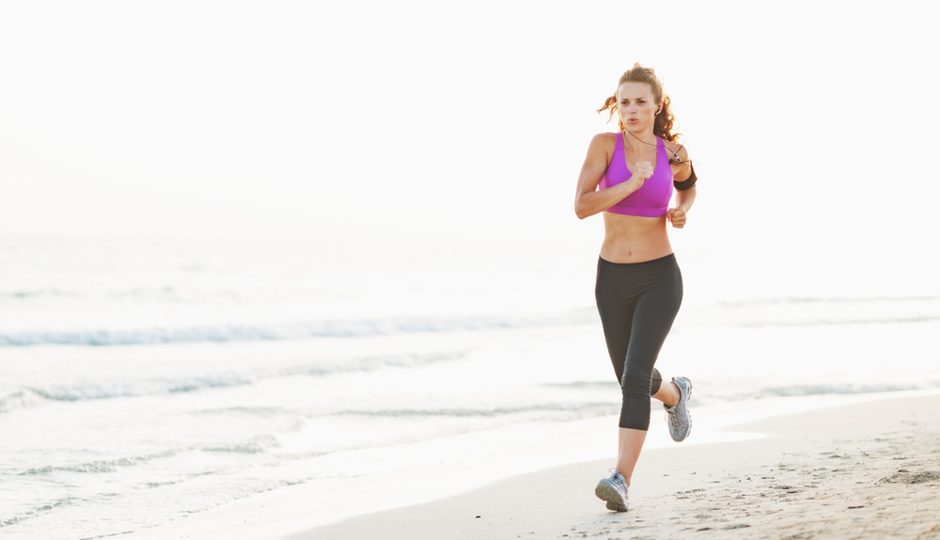Expert Advice: How to Survive Hot Summer Runs

Shutterstock
Aren’t Philly summers great? Weekends down the shore, pop-up parks, street festivals and outdoor dining galore make it a great place to be. Enjoying the outdoors is just plain easier in warm weather. Except, perhaps, if you’re running.
Summer in Philly, for the average runner, means overheated runs, dripping sweat, and the constant desire for water. And, as if that’s not enough to deal with, odds are you may find yourself struggling to keep a pace or finish runs that seemed easy just two months earlier, which can cause you wonder, “What’s wrong with me, am I getting worse?”
I’m here to tell you, no, you’re not getting worst. Running in the high heat and humidity has negative effects on your running pace and there is no way around it. Extreme heat and humidity can have anywhere from a five to 30-second impact on your average mile pace depending on the distance, pace and weather.
Frustrating, right? However, understanding why your pace suffers can help you deal with the frustration of running slower paces. Here’s the deal: As you run, your core body temperature rises. In an effort to maintain a safe core temperature, your body adapts by directing a greater percentage of blood flow to the surface of the skin. The higher the temperature, humidity and dew point, the more blood will be directed to the skin’s surface to be cooled. This increase in blood towards the skin causes a major problem for endurance athletes because it reduces the amount the blood available for the working muscles, and blood is a key ingredient in the process of generating energy.
As if that’s not enough to fight through, your body also has trouble taking in as much oxygen when’s its hotter, which means less oxygen is going to your muscles. Having less blood and oxygen flowing to your muscles is like trying to water your garden with a leaky hose. Sure, you’ll get it done, but it will be slower. The same goes for your running pace, sure you’ll able to do it, it will just be slower.
So, now that hopefully you accept the fact your pace will suffer, here’s what you can do to deal with it and run the best you can on gruelingly hot and humid days.
1. Run by perceived effort verses actual pace.
“Just run by effort” is something you’ll hear experienced runners say all the time. What does that mean though? Running by perceived effort is judging your running pace by how hard it feels instead of how fast your moving. As we just learned, our bodies have to work harder in higher temps and humidity. Using the perceived effort scale in the summer accounts for the additional stress heat places on our system.
For example, if running eight-minute miles felt like a four (moderate effort) on a one to 10 perceived effort scale in 50-degree weather, you’ll need to adjust your pace for 90-degree days with 90-percent humidity in order to maintain that same perceived effort. So your actual running pace in the heat may be 8:20-minute miles, however it’s placing the same amount stress on your body as the eight-minute miles did in ideal conditions. Get it?
2. Run in the mornings or late evenings when it’s cooler
This one is pretty straight-forward. Running when it’s cooler — say at 6:30 a.m. or 8:30 p.m. — means your body won’t have to adjust to the heat quite as much and your pace won’t suffer quite as much.
3. Dress properly.
This means wearing light-colored clothing made of a moisture-wicking material and avoiding cotton. Remember how I mentioned, as we run our core temperature rises? Well, the main way our body cools itself isn’t through the actual process of sweating but through the evaporation of that sweat. If the sweat cannot evaporate from your skin, it inhibits your ability to cool down. Technical wear is designed to wick the moisture away from body so it can continue to sweat and cool itself.
This explains why humidity and, the lesser-known but more important factor. dew point affect performance more than the actual air temperature. The higher the humidity and dew point, the harder it is for sweat to evaporate off your skin. So do yourself a favor and wear the right gear.
4. Adjust your goals.
As I tell my clients, summer is not the time for amazing performances, especially in the longer distances like the half marathon and marathon. (This is why it’s hard to track down longer races in July and August.) Your body just doesn’t operate as efficiently as it does in ideal racing temperatures. The key here is to run shorter races, look to have fun and use the perceived effort scale until the temps start to drop and, odds are, you’ll be surprised by how paces that felt hard in the summer feel very easy again once it cools down.
And please, please, please accept that your pace will suffer and understand this is not a reflection of your actual fitness level. Lastly enjoy it while it lasts, because soon enough it will be 12 degrees with a -5 degree wind chill and you’ll be begging for this 90-degree weather to return.
……………
Cory Smith, a Philadelphia based running coach, shares his expert advice as an American Cancer Society DetermiNation running coach; founder of Run Your Personal Best, a private running-coaching business; and head cross country coach at Penn State Brandywine. He is a USA Track and Field-certified coach and a 4:03 miler. As a student athlete at Villanova, Cory was an NCAA Division One Regional and National Championship qualifier. Contact Cory at cory@runyourpersonalbest.com. Read all of Cory’s posts for Be Well Philly here.
Like what you’re reading? Stay in touch with Be Well Philly—here’s how:
- Like Be Well Philly on Facebook
- Follow Be Well Philly on Twitter
- Follow Be Well Philly on Pinterest
- Get the Be Well Philly Newsletter


